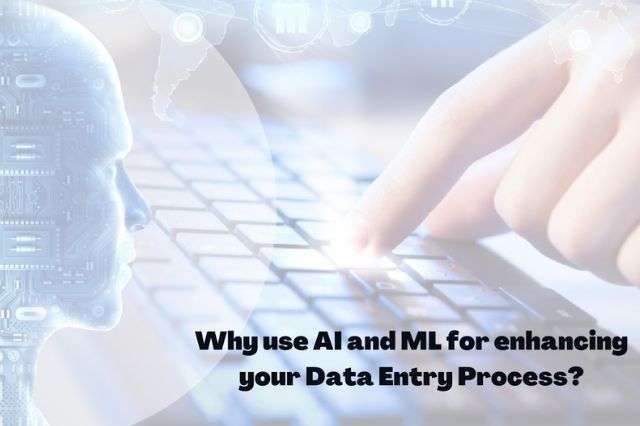Why Use AI and ML for Enhancing Your Data Entry Process?
Data entry is a crucial element of a company’s data management process. However, manual data entry is time-consuming and prone to errors, making it challenging to handle the scale and complexity of large datasets. Moreover, as data volumes continue to grow exponentially, human data entry becomes increasingly inefficient and impractical.
To address these challenges, businesses are turning to automation through Artificial Intelligence (AI) and Machine Language (ML) technologies. By automating data entry, businesses can improve accuracy, speed up data processing, and reduce costs associated with manual labor.
This post details why you should opt for an AI and ML-based data entry process by laying out the benefits offered, the possible challenges one might encounter, and how opting for an external data entry services provider may be necessary to fully maximize the benefits of the automated data entry approach.
The Benefits of Using AI and ML for Data Entry
The introduction of artificial intelligence (AI) and machine learning (ML) has opened doors to automated data entry systems, offering a multitude of advantages.
Here are some significant benefits that organizations can gain by utilizing automated tools for data entry.
- Inimitable Accuracy
If there is one thing that automation is known for, it’s its accuracy in performing functions with predetermined parameters. And that’s exactly what makes for good data entry. Automated data entry using AI ensures high accuracy and fidelity, reducing the risk of errors that are common in manual data entry operations. The automated systems are trained to recognize patterns & anomalies and adjust their data entry processes accordingly. This adaptability allows the system to maintain accuracy even in dynamic data environments.
- Increased Efficiency
Manual data entry is a time-consuming process that requires a lot of manpower. Businesses can reduce the time taken to input data by using automated systems that can enter large volumes of data quickly and accurately. This frees up time for employees to focus on other important tasks that require human attention. By automating the data entry process, businesses can increase their productivity and efficiency.
- Cost Reduction
The traditional method of manual data entry is costly, especially for businesses that deal with large volumes of data. Hiring a team of employees to input data can be expensive, and the cost increases with the volume of data. However, automating the process offers a cost-effective solution due to the requirement of minimal human intervention, which reduces the need for a large team of data experts.
- Improved Data Quality
AI-enabled systems offer significant benefits in terms of minimizing the risk of human error inherent in manual data entry processes. The automated data entry process implements data cleansing and enrichment functionalities to identify and rectify errors, duplicates, and inconsistencies within the database. This systematic approach leads to the generation of cleaner and more reliable data, consequently elevating the overall quality of the data.
- Scalability
As businesses generate and handle larger volumes of data, working with traditional manual methods can be overwhelming and inefficient. AI and ML technologies offer the ability to process vast amounts of data quickly and accurately, without compromising on quality or speed. This scalability empowers businesses to handle data growth effectively, supporting their expansion and operational needs.
- Multi Data Type Adaptability
Long gone are the days when data only meant textual information. In today’s age of multimedia, companies rely on a variety of data types to push toward fulfilling their objectives. And data entry has also adapted to this requirement by enabling the inclusion of audio, video, animation, images, HTML web pages, and other types of data into its purview. On the side of automation, there are AI models and Ml algorithms that can help ease the process of entering all types of data. Custom-developed AI models can be tailored to read and accurately enter diverse data types using data annotations.
The Challenges to Using AI and ML for Data Entry
Although AI and ML technologies serve to be a boon for automated data entry, they are accompanied by certain challenges. Hence, without proper implementation of AI and ML tools for data entry by considering their limitations, you could end up with unanticipated problems.
- Integration with Legacy Systems
Many organizations have legacy systems that were not designed to work with AI and ML technologies. Integrating AI and ML into these systems can be challenging and require significant investments in time and resources. Organizations must evaluate their existing systems’ compatibility with automation tools before implementation.
- Cost of Implementation
Automating data entry processes can come with a significant upfront investment in technology and implementation. Organizations must invest in hardware, software, and human resources to deploy the process effectively. Additionally, there may be ongoing maintenance costs to ensure that the systems remain up-to-date and secure.
- Lack of Human Oversight
Automation offers numerous advantages, including increased efficiency, faster processing times, and reduced costs. However, there is a potential downside to relying solely on automation: the absence of human oversight. Without human supervision, there is a risk of errors or incorrect decisions going undetected. To strike a balance, organizations need to integrate manual intervention to implement quality control measures, such as regular audits, data validation checks, and verification procedures.
- Poor Quality Training Data
One of the primary challenges of using AI and ML for data entry is the quality of data used for training the models. The performance and accuracy of these models heavily depend on the data they are trained on. If the training data does not adequately cover the range of data types, structures, and variations encountered in real-world scenarios, the models may struggle to accurately interpret and process the data during the entry phase. Moreover, without proper monitoring and retraining, the models can become outdated, leading to a decline in data entry accuracy.
- Handling Data Compliance
Automating data entry requires adherence to data handling regulations and privacy laws, such as the General Data Protection Regulation (GDPR) or the California Consumer Privacy Act (CCPA). Organizations must ensure that the automated processes are designed to comply with these regulations, including obtaining necessary consent, implementing data access controls, and providing transparency to individuals regarding their data usage.
- Bias in Data
AI and ML models used for automated data entry rely on training data to learn patterns and make decisions. If the training data is biased or contains inherent prejudices, the automated system may replicate and perpetuate those biases during data entry. For example, if historical data is biased toward a particular demographic or excludes certain groups, the automated system may unintentionally discriminate the same. Therefore, organizations should hire experienced data annotators for labeling and training the models.
How to Overcome Automated Data Entry Challenges?
To address the challenges encountered during automated data entry, there are two viable approaches to consider. One option is to establish an in-house team of experts dedicated to training AI/ML models tailored to the organization’s specific requirements. The alternative is to outsource the automated data entry process to a reputable company. While both solutions have their merits and drawbacks, outsourcing proves to be the superior choice for organizations seeking to streamline operations and minimize costs associated with building an in-house team.
Here are the benefits of outsourcing the automated data entry process:
- The expertise of third-party professionals in handling the AI and ML tools helps make the job faster. With an in-house team, you may need to put them through a training phase, which can cost significant money and time.
- It reduces the turnaround time because of the possibility of the third-party agency working across time zones.
- External data entry service providers have tight data confidentiality and privacy measures in place, and can, therefore, overcome the data security issues associated with using AI and ML tools.
- By outsourcing, businesses can save time and resources, allowing them to focus on core activities while the data entry experts handle the data management workload.
- Expert data entry service providers ensure a high level of accuracy and quality in data entry tasks, minimizing errors and maintaining data integrity.
- Outsourcing data entry helps in scaling operations effectively, as businesses can easily increase or decrease the volume of data entry tasks based on their needs.
- Data entry experts utilize advanced tools and technologies to streamline the process, resulting in improved efficiency and faster turnaround times.
Conclusion
The realm of data entry is undergoing rapid transformation with the integration of AI and ML tools. This automation empowers companies to streamline their operations and align themselves with industry standards, achieving enhanced performance. By embracing data entry automation, your company can unlock a multitude of advantages offered by the latest technologies, including expedited processing times and heightened accuracy. These benefits, in turn, bolster your decision-making processes and pave the way for improved efficiency and productivity. So, embrace the potential of AI and ML in data entry to propel your business forward and stay ahead in today’s dynamic landscape





